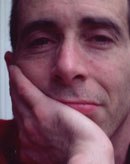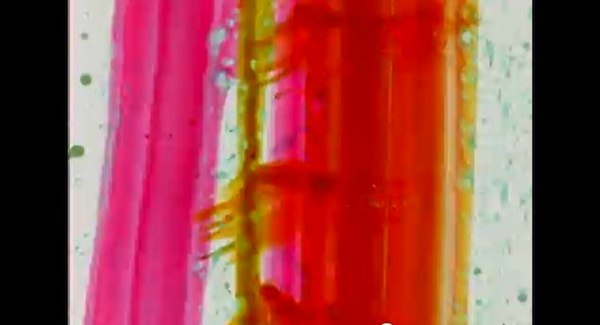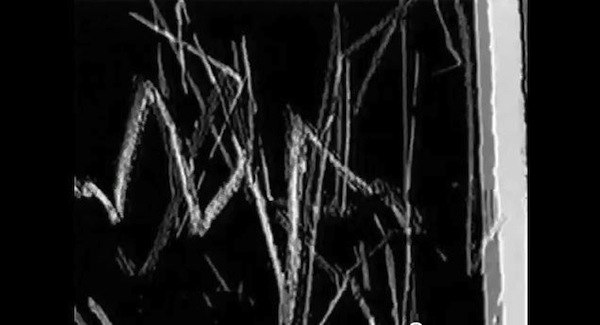Steven Woloshen creates animation in cars, at work, in airports, on planes… in other words wherever and whenever he has ten consecutive minutes to play. We chatted over bottled water at the Ottawa International Animation Festival this past October, and continued by email after his return to Montreal.
Steven Woloshen animates in cars, at work, in airports, on planes… in other words wherever and whenever he has ten consecutive minutes to play. He's rarely without his animation kit, a small wooden box containing raw film footage, inks and associated marking instruments, and a flashlight. He works directly on previously exposed filmstrips, animating to the most terrific jazz music. Exploring new modes of mark making, he recently added the element of raw decay, burying footage in his backyard and raising it after the worms have had their fill. Curious yet? May I recommend his book, Recipes for Reconstruction: the Cookbook for the Frugal Filmmaker.
We chatted over bottled water at the Ottawa International Animation Festival this past October, and continued by email after his return to Montreal.

sk: Steve, I've seen the word experimental attached to all kinds of animation including yours. What does experimental mean to you?
sw: When I think about my art, I don't consider it experimental. I've been told that experimental means "Underground". I would like to think of my work as very "above-ground" and entertaining.
In my daily practice, I'm always trying to put myself into an entrepreneurial position. I want to take some risks with every film. And I want the audience to know I've taken those risks. I have trained myself not to make cuts or edits so I can focus on my urges and desires when I'm listening to my soundtracks. I have also promised myself that I would not preview my films in progress. I want to be the first audience member to surprise myself when I view the final film. In this way, I sort of think as a Dadaist would when creating an "exquisite corpse."
To me, "experimental" is a very broad term. I once asked a festival how they defined their experimental category. They said they were looking for "edgy." I still don't know what that means, and it certainly doesn't sound like any of my films. I want to be happy. I want my audience to feel happy when they see a film like "Playtime" or "Bru Ha Ha!" I would like to achieve the results that the impressionist painters were aiming for, that the artist does not hide his hand to "interpret" reality.
sk: I’ve always been delighted by your films. (Well almost always; there was one, a horror back a decade ago, that I wasn’t sure about). I’m watching Cameras Take Five (2003) right now which is, I think, one of your classics. How have you films changed since early 2000? And has your recent participation in an MFA program had an impact on your style or what you look for in a film?
sw: My film style has changed a lot since I began painting and scratching on 16 mm and 35 mm film. I feel that I've have been blessed with good responses to my films . For example, I've always liked the many responses to Cameras Take Five over the years. Sometimes, I google the title and like reading how people greet the film. I've even read that it has been cited as an example of non-objective, hand made filmmaking in a few animation school syllabuses. These facts have encouraged me so much that I've become more daring as a filmmaker. If I take an idea out to "left field", I feel that the movie will be greeted with good humour by the audience (who may have seen some of my earlier works). Because of these positive responses, I've felt more confident to try new techniques. Even if they don't end up in a final film, I love trying new things. Recently, it has focused around decay, photograms, loops, and gluing film on film.
In 2007, I enrolled in the MFA program at Concordia University in Montreal. At first, I was a little scared and even offended that I couldn’t paint on film. (In reality I could but the faculty was hoping that I could move into a new direction) As a result, my thesis advisor Richard Kerr taught me how to love a silent image. He really encouraged my interest in the beauty of film decay and encouraged me to turn my thesis written component into my first book, Recipes for Reconstruction: the Cookbook for the Frugal Filmmaker. Because of the MFA, I also felt comfortable in a gallery/museum environment. I find it a lot easier to talk and write about my films, too. And to participate on juries and contribute to animation catalogues.
The MFA hasn't ruined my appreciation for camera-less animation. Now I feel that I have more choices and more ways to express myself with the things I find interesting. I always wonder: If music can make us think of a color, can it also make us think of a movement? Can music remind us of a damaged and decayed image? I think about these things every day.
sk: For other filmmakers considering the same route, what do you think are the benefits of doing an MFA, and what are the downsides?
sw: Well, let me start by recounting my own experiences. I enrolled in the film production MFA program at Concordia University's Mel Hoppenhiem School of Cinema at the age of 47. I was really nervous about my decision. I thought my age and experiences would alienate me from the other people in the Studio Arts program. They were half my age and they all seem to be really gung-ho. They were mostly young, single people who had so much energy and ideas to contribute to the program. As the first year rolled on, my seminar papers were described as "a roller coaster ride of ideas," I was worried that I didn't have the theoretical background or academic rigor to continue in the program.
By December, things started to turn around. I found that I was more focused than most of the people around me. I was older. I could deal with disappointment and rejection better than the other student/artists. If I didn't understand something, I wasn't shy to ask for clarification. I had an arts practice that required public projections, panel groups and interviews. This made me a lot more confident in my class presentations. I had also worked in so many odd sectors of the Canadian work force (i.e. door-to-door insurance sales, lab work, etc.). My life experiences were interesting to my fellow students.
I would recommend an MFA program with the following conditions: An applicant should take some time to build an arts practice before enrolling in the MFA program. Life experiences are great assets to bring to an arts program. An applicant should have a general idea of direction before the program commences. Even if the initial idea sounds crazy, keep focusing on some aspect of your original thesis throughout the three year program. And finally, an MFA program shouldn't be a place for technical training. It should be a safe and liberal place to test your ides in a public arena and a chance to verbalize some of your inner thoughts.
sk: Which animations by other filmmakers speak to you most directly? What it is about these works that you love?
sw: The Bunny of Seville is where it really began for me. When I was a kid, I had to wait through all the Bugs Bunny cartoons on the Bugs Bunny Road Runner Hour to see The Bunny of Seville. I had to wait and watch for weeks. When I found out that you could buy the Barber of Seville overture on vinyl, I had my parents buy it. I listened to it every night as I imagined the cartoon action. Soon I forgot the content of the cartoon and I began to make my own stories.
Fischinger's Hungarian Rhapsody film Study no. 7 (1931) still enthrals me. It's so simple and so charming. The technique is intriguing too. Charcoal on white paper. I love this.
Everyday of my life, I can't stop thinking of the Bolero sequence from Allegro Non Troppo (1976). So much fun and a real tribute to the spirit of the music.
Also, I saw a print of Lye's Free Radicals in college in 1979. I knew that if Lye could create with such simple tools, then I could make a scratch film as well. I had so much scrap film-stock lying around my room (of my parent's house) it was hard to avoid the temptation to make a film.
Outer Space by Peter Tscherkassky (1999) is a new find for me, and also one of the reasons for writing and compiling material for my book Recipes for Reconstruction. I love the idea of photograms, reprinting painting with light from laser pen.
In my films I don't think about narrative vs non-narrative or even about "avant garde". I want to tell a different kind of story. Maybe the simplest kind of story. But a story that's in my heart.
It's a rare animation festival that isn't screening a Steven Woloshen film in competition. Catch one if you can. Steve produces at least one finished film a year and you're guaranteed a foot tapping, finger snapping, backside wriggling experience. In the meantime a number of Steve Woloshen's recent films can be viewed online on 24/25 Le portail des images en mouvement (The Portal of Moving Images).
For a copy of Recipes for Reconstruction: the Cookbook for the Frugal Filmmaker, contact the author directly at swoloshen@hotmail.com. Cameras Take Five is available for purchase on the NFB compilation DVD Volatile Materials. For copies of the other films, contact the filmmaker directly.












